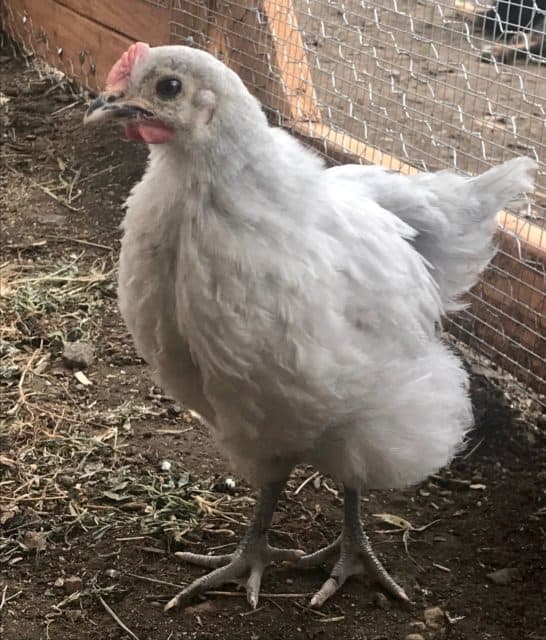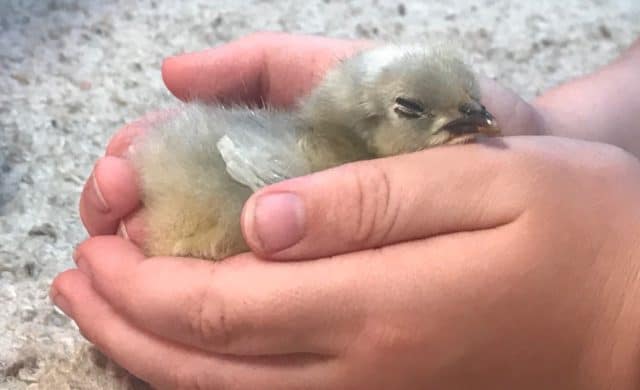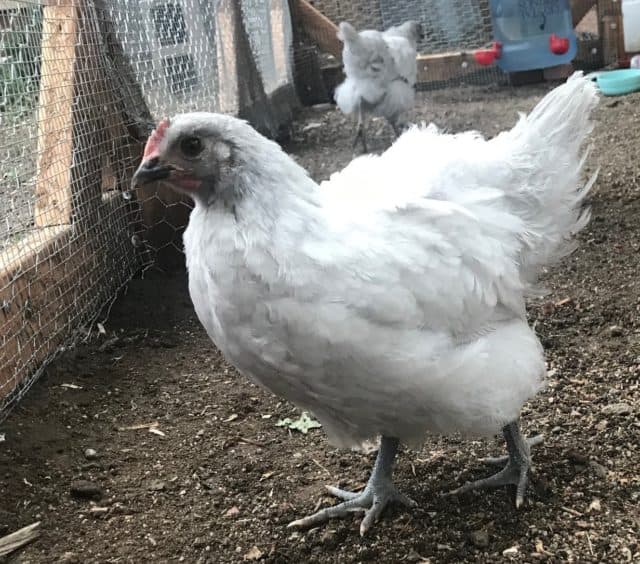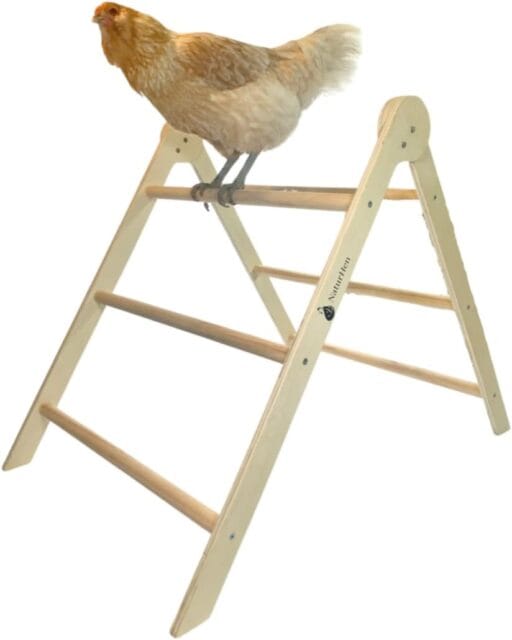
Lavender Orpington chickens just might be the perfect breed for a backyard chicken flock. These are delightful birds that make an excellent “starter” breed for your first chickens. They also make a wonderful addition to any flock.
When you start or add to your chicken flock, you’ll find yourself inundated with hundreds of breed options. From fuzzy silkies to giant brahmas, the choices are practically endless! If you want to have chickens that are suited to the family backyard, however, you’ll have to select your breeds carefully. And for the perfect urban family backyard chicken breed, look no further than the Lavender Orpington chickens!
Lavender Orpington chickens are beautiful, fluffy, friendly birds with silvery-blue feathers. Maxing out at 6-8 pounds, their color and puffy appearance makes them look like soft, grey clouds wandering around the yard. They are good egg layers, sweet-natured, and great for beginners and children. With so much to love, it is no wonder this breed is so highly sought-after.
Editor’s Note: If you are new to keeping lavender orpington chickens–or any breed of chickens, check out A Beginner’s Guide to Raising Chickens for lots of great information about chicken breeds, raising an urban chicken flock, and more.

History of Lavender Orpington Chickens
The first Orpington chickens were bred by William Cook in the 1800s, who named them after the small town of Orpington, England. Cook bred them to be the perfect dual-purpose bird, meaning great egg layers and great meat birds for the dinner table.
Cook took his prized Orpingtons to U.S. poultry shows, and the breed was an instant hit. Before long, the original black-colored Orpington was joined by several other colors, including white, red and the American favorite: buff.
During the mid-20th century, when small homesteads were replaced by large-scale poultry farms, the Orpington breed fell out of favor. Orpingtons were eventually placed on the “threatened” breed list. But during the past 30 years or so, the breed has seen a resurgence as a family and show breed. Today, Orpington chickens are more popular than ever.
Lavender Orpington chickens are a more recent addition to the Orpington family. The color, introduced in the late 1990s, is technically a very diluted black. It resulted after decades of breeding in the U.K. This color breeds “true,” so two Lavender Orpington chickens will produce all Lavender babies.

Need a chicken coop or other chicken-keeping items? Check out the Chicken Supplies on Amazon.
Temperament of the Breed
The more common Buff Orpington is known as the “golden retriever” of the poultry world for its sweet disposition, and the Lavender Orpington is proving to be just as friendly! When raised from chicks, these birds love to come when called, hop up on laps, and settle in for cuddles and treats. Because they are so docile, Lavender Orpingtons make great pets for families with children.
Their gentle nature extends to the roosters too. Lavender Orpington roosters make good protectors, but they tend to be non-aggressive towards people. If you find yourself in the city and one of your Lavender Orpington chicks turns out to be a rooster, chances are he will be easy to re-home.

Lavender Orpington Chickens in Urban and Suburban Backyards
Several factors make Lavender Orpingtons ideal urban backyard chickens:
- They have a quiet, calm nature that your neighbors will definitely appreciate. (Other breeds — even the hens — can be very loud).
- They take to captivity well, so they can be kept in a nice chicken run all day without fighting.
- If you let them out to wander the backyard, their heavy bodies stop them from flying over your fence and getting into trouble.
- They should lay plenty of extra eggs to give away – another big plus if you want to keep the neighbors happy!
Physical Traits
Lavender Orpingtons are very similar to their Buff cousins. They are clean-faced (no muffs or beards), with small-medium sized combs and wattles. Their legs and beak are a slate grey to match those silver feathers. Like the Buff, this breed is well-feathered and moderately fluffy, making them seem much bigger than they really are. Their tails are short, and their back is rounded. They stand fairly upright. Eye color can vary.
Lavender Orpingtons are very cold hardy and thrive in cooler climates. They are not prone to frost-bite. In the summer though, those thick feathers make them prone to heat stroke. So, give your Orpingtons plenty of shade and water. Feed them a quality diet to maintain their beautiful feathers.
Want to see how adorable Lavender Orpington chicks are? Check out this video.
Broodiness
Broodiness is the instinct to sit on a clutch of eggs and become a chicken-mom. Fortunately, broodiness is a well-known trait in Lavender Orpington chickens. They tend to “go broody” once or twice a year, and they make excellent mothers.
Egg Production
One great reason to consider Lavender Orpingtons is their eggs. Hens are moderate to heavy layers of large light brown, pink-tinted eggs. Average is about 200 eggs per year. They won’t exactly out-lay a Leghorn, but their production is plenty for a small family.

Are Lavender Orpington Chickens Right For You?
If you are considering a Lavender Orpington to add to your flock, there are a couple of things to consider:
- This breed is both uncommon and highly prized, making it a prime candidate for inbreeding. Make sure you get your Lavender Orpington chicks from a reputable hatchery or local breeder.
- The breed’s rarity and popularity also makes it more expensive than your average backyard hen. Lavender Orpington pullets can cost up to $30 each from a hatchery.
- Like all Orpingtons, this breed is not the most savvy free-range bird. They are good foragers, but they can’t fly well, Plus, they are poor at watching out for predators. Keep your free-ranged Orpingtons in a well-guarded flock to give them a little extra protection, and they’ll do just fine.
- Lavender is not yet an “acceptable” color for Orpingtons with the American Poultry Association. So, unfortunately you can’t exhibit them for ribbons. They are, however, an excellent showmanship bird for children in 4-H and other clubs.
- Lavender Orpington chickens are so calm and docile that they are often targets for bullying by more aggressive breeds. Keep an eye out for signs of pecking and plucking.
Get Started Here
Are you just getting started in your chicken-keeping hobby or business? Local farm and ranch stores are an excellent source of chicken supplies and information. So is the Internet. If you’re just getting started, you might not know chickens love to hang out on roosting bars, such as the one below. Check out this Chicken Roosting Bar on Amazon.
A Final Thought on Lavender Orpington Chickens
The Lavender Orpington is a well-rounded breed that will thrive as an urban backyard chicken. Their beautiful feathers, sweet disposition and large brown eggs make them a worthy candidate for your suburban flock.
Are you an avid vegetable gardener?
Read Grow More Vegetables in a Square Foot Garden.
Home Garden and Homestead earns a small commission from qualifying purchases on Amazon.com and other partner sites when you click on a link and buy a recommend product. Thanks for supporting this website!




I have read your story about these wonderful birds. Where can I buy fertile eggs? Thank you!
To find fertile eggs, do a Google search for “buy lavender orpington eggs.” You will get several options of companies that will ship eggs to you. You can also Google “buy lavender orpington eggs near me” to see if there are any local options. Good luck!
My husband bought 4 Lavender Orpington pullets yesterday at Tractor Supply in Henderson, Texas. He also bought five Black Copper Marans, and two little black and white splash looking chicks called Oreo chicks. I had never heard of them before, but they are cute!
Would these chickens do well in east Texas as summers get upwards to 100°?
Delsie–
Orpingtons do OK in the heat, despite their fluffiness. But they (and all chicken breeds) benefit from shade from the summer sun, a cooling mist and perhaps a fan to keep the air moving.
Randy Schultz
I just bought 3 lavender Orpingtons from a feed store. So far they are doing great they are 2 weeks old.